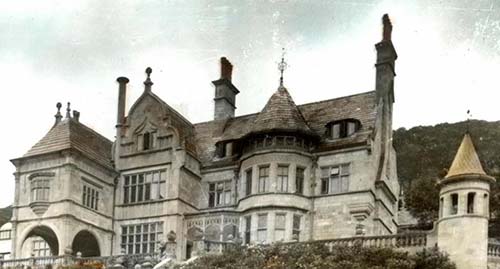Hebden Bridge Local History Society
Remembering Cragg Hall 1820 – 1921
Speakers: Shirley Daniel and Roy Collinge
Monday, 28 March 2022
On the morning of the twelfth of August 1921, the residents of Cragg Vale woke to find their landscape changed: the magnificent Cragg Hall, part of the fabric of the community, was a smouldering ruin. After a hundred years there is no-one left with memories of the Hall, so Shirley Daniel and Roy Collinge of the Cragg Vale Local History Group decided that they would delve into its history and tell the tale of what was acclaimed as one of the finest buildings in Yorkshire.

The audience at Hebden Bridge Local History Society were introduced to the enterprising Hinchliffe family who made such a mark on the community during the changing times of the 18th century. Samuel Hinchliffe and his descendants were clothiers who were keen to innovate and exploit the water power of the area. His son Richard Hinchliffe built the first mill in the valley, and soon had an empire of properties, with more mills and cottages built for the workers.
The dynastic ambitions came to a peak in the nineteenth century with Hinchliffe Hinchliffe, who with the help of some inherited money, purchased the Cragg Hall estate, and started building a new house to replace the rather modest original which then became known as Old Cragg Hall.
Hinchliffe Hinchliffe was apparently not a man to splash out his money, and was known to be strict with his children, making sure that they worked at least as hard and long as his workers. He helped local charities, but he also continued to enhance the wealth of the family by investing in land for building. He did not have luck with his family however – his sons and a nephew who were set to inherit all died young.
His surviving child, Helen, was seen as a headstrong young woman, and after she eloped there was not much hope that she could safeguard the Hinchliffe legacy. After being widowed twice, and left with a fortune by her second husband, she met and married 21 year old William Algernon Simpson, a bank clerk who was thirty years younger than her. Mr and Mrs William Algernon Simpson-Hinchliffe formed the partnership which created the magnificence of Cragg Hall.
Unlike her father Helen was keen to spend her money and immediately after the marriage in 1902 brought in architect Edgar Wood, prominent in the Arts and Crafts style, to begin the transformation of the hall, with a gothic archway to the grounds. At Christmas the house was thrown open to workers and neighbours, with a generous Santa and a sumptuous meal at the Sportsman's Inn.
Over the next few years the couple continued to extend the Hall, which doubled in size and was transformed and modernised following the fashions of the time. There were fanciful towers and turrets, an elaborate covered porchway where carriages could be received, a hall with a magnificent staircase, a drawing room and a billiard room. Like all the best mansions of the time they innovated with electric lighting and had an ice house, a cold store and hot house to supplement their entertainment.
Over a few years, the grounds were landscaped to give a terraced garden designed for pleasure, with tennis courts, croquet lawn, a gazebo and fountain and a revolving summer house. With the completion of the bathing pool and boating lake, in 1907 Cragg Hall was ready to celebrate and staff were invited to a fabulous garden party, which was captured on photograph. The list of guests who were entertained at Cragg Hall includes the celebrities of the day such as Dame Clara Butt. Sadly, there are no surviving photos of the internal decoration of the Hall.
The Simpson-Hinchliffes were civic minded people, generous and involved in the social life of the valley. Algie was keen on sports and fancy cars, once transporting his racing pigeons in his Rolls Royce. He bred race horses, including a champion hunter called Broadwood. He also had political ambitions, standing as Conservative candidate for parliament. After the outbreak of war, Algie bought his own ambulance and drove out to the front, while Helen worked as a nurse. However, she became seriously ill and died in London in 1917.
Algie then lived alone at Cragg Hall and in 1921 was preparing for the sporting festivities of the 'Glorious Twelfth'. It was he who first noticed the burning smell and rescued the maids. There was an attempt to call the fire-brigade while the house staff and neighbours tried to fight the fire. Eventually the horse tender from Hebden Bridge arrived and the more modern motor machine from Halifax. It seems that there was a frantic effort to pump water from the river, but falling masonry destroyed the hose, and the rain that arrived at dawn fell on a ruined house. Soon after this Algie sold the mills, and moved to Wetherby where he lived until his death in 1963.
The life of the Cragg Hall estate continued under the direction of another local character: Tar Billy (as William Sutcliffe, a road constructor, was known) continued to open the grounds for local events and built New Cragg Hall on the footprint of the old mansion. Some of the garden survives, reached through the original gate-house, with hints of a century's old magnificence.
Details of the History Society talks programme, publications and of archive opening times are available on the History website and you can also follow History Ssociety Facebook page.
With thanks to Sheila Graham for this report

